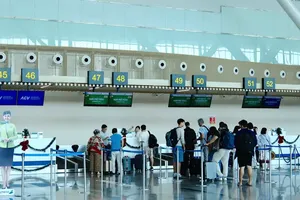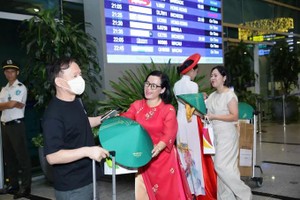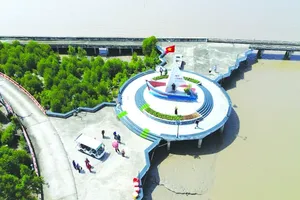
According to Phu Quoc Express - the investor - the primary reason for the suspension is the inadequacy of port conditions and road connections, which has made it difficult to attract passengers. Meanwhile, many passengers attribute the suspension to the operator's failure to fulfill its commitment to provide free passenger transfers.
General Director Vu Van Khuong of Phu Quoc Express said that the operation of the route has encountered numerous challenges, affecting passenger choices. These challenges include the Saigon - Hiep Phuoc Port being located far from the city center, requiring passengers to be transferred from the city center to the port or to make their own way. Additionally, weather conditions have also impacted the efficiency of passenger transportation.
He added that the company has decided to temporarily suspend passenger transportation on this route to seek more suitable solutions. Once a suitable solution is found, it will be submitted to the authorities for consideration and approval to resume operations.
According to Mr. Khuong, after nearly two months of operation, the passenger volume has reached less than 50 percent of the capacity of each trip. Specifically, on weekdays, the ferry carries an average of 200 passengers, while on weekends, this number increases to 600-700 passengers per trip. This is lower than the expected average fill rate of 70 percent-80 percent and also lower than the Vung Tau - Con Dao route.
Since its opening, the company has not received feedback from customers regarding the transportation or services on the boat. Most complaints are related to inconvenience during travel and boarding at the HCMC terminal, which is more than 20 km from the city center. Although the company has arranged shuttle buses, there are still some issues. Additionally, the primary operation is maritime, so there is a lack of road experience.
Being a passenger who used to go to Con Dao on a high-speed ferry, Mr. Pham Nguyen Thanh in HCMC mentioned that previously, flying to Con Dao by plane was expensive, especially during holidays and weekends. Since the high-speed boat route became available, he and his friends decided to choose this mode of transportation. While the onboard service is good, the journey from central TPHCM to the Hiep Phuoc port is quite challenging.
Mr. Thanh and his group from District 12 had difficulty finding their way to the port, spending 1 hour and 32 minutes on a detour. They had to consult maps frequently due to their unfamiliarity with the route.
Moreover, the distance from the motorcycle parking area to the port is over 1 km. Despite the large number of passengers, shuttle buses are limited, resulting in many people walking with their luggage. On the return trip, several passengers struggled to find transportation back to the city center. Residents of the city still face difficulties, and this situation is likely even more challenging for long-distance travelers and older adults.
Director Nguyen Kim Toan of Thuong Nhat Company (Saigon Waterbus - the river bus operator in Ho Chi Minh City), pointed out that the Hiep Phuoc port is distant from the city center. Even with shuttle buses picking up passengers at the Bach Dang terminal in District 1, travelers still encounter inconveniences due to multiple transfer points and cumbersome registration procedures.
Those arriving by private cars must pay additional fees to enter the port, in addition to the ticket price. The services around the port area are underdeveloped, and transportation connections remain inadequate, making it difficult to find taxis and causing inconvenience for passengers.
Many experts agree that management agencies need to coordinate with businesses to address transportation connectivity challenges at the Hiep Phuoc port. One proposed solution is to explore using the Ben Nghe port in District 4, near the city center as an entry point for boats, providing convenience for passengers. This approach aligns with the city’s river tourism development plan, which aims to enhance waterway transportation.
If the boats continue to depart from the Hiep Phuoc port, the operating company should organize comprehensive passenger transportation services, factoring these costs into ticket prices.
Additionally, attention should be given to waterway transportation connections, including docking facilities for yachts and tourist boats. Simultaneously, the ferry company should implement attractive policies to entice passengers, such as providing food and beverages throughout the journey.
According to evaluations by the Ho Chi Minh City Department of Transport, the high-speed boat route from Ho Chi Minh City to Con Dao has operated safely according to regulations. Each departure is closely monitored by the Maritime Port Authority and the Border Guard Force. This fixed passenger transport route from the shore to the island is the first trial run, so the projected passenger volume for the business is not yet accurate, currently reaching only 30 percent to 40 percent of operational capacity.
In response to the sudden news of the suspension of the Ho Chi Minh City - Con Dao high-speed boat service, Deputy Director of the Ho Chi Minh City Department of Transport Bui Hoa An stated that the department is collaborating with the Maritime Port Authority of Ho Chi Minh City to assess the operation of this high-speed boat route.
Following their discussions, the parties will seek solutions to encourage and support businesses while ensuring convenient and reasonably priced travel for passengers on the Ho Chi Minh City - Con Dao route. Mr. Bui Hoa An believed that this form of public transportation requires time to establish travel habits among residents and improve service quality to attract more passengers.
























